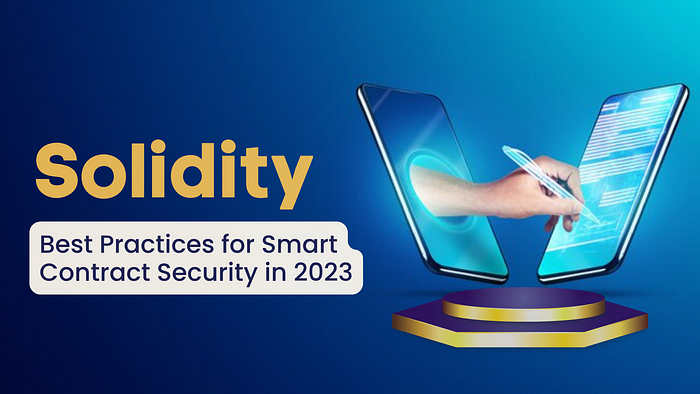
In essence, smart contracts and blockchain solutions are related concepts because the latter provides a distinctive method for carrying out transactions. Smart contracts are digital representations of actual contracts or agreements that are set up to carry out certain blockchain services when particular triggers are detected. Solidity is one of the most widely used blockchain programming languages for building smart contracts.
As a result, a lot of blockchain consultants and enthusiasts are interested in learning about solidity best practices to enhance their professional brilliance. Since smart contracts can have some flaws, security is the main issue to be addressed when creating them with solidity. The explanation that follows delves into a fundamental understanding of solidity and the many smart contract best practices you must adhere to when using the language.
The definition of smart contracts is the first issue raised while discussing the best methods for doing so with Solidity. A high-level, contract-oriented language with syntax resembling JavaScript is presented by Ethereum Solidity. The Ethereum Virtual Machine, or EVM, can run machine-level code written in Solidity. Additionally, Solidity’s compiler takes high-level code as input and decomposes it into simpler instructions.
1. Be prepared for the unexpected
One of the fundamental rules of security focuses on avoiding failure at all costs. It is crucial to remember that any significant smart contract is likely to contain a number of faults. Therefore, the code should be able to quickly and effectively adapt to bugs and vulnerabilities. Following are some noteworthy solidity security recommended practices to aid in your failure readiness:
- Additionally, developers need to make sure that the money in the smart contract that is at risk is managed effectively. The term “rate restriction” and “maximum usage” refer to the typical techniques for completing this operation. In some circumstances, the sudden influx of requests for a specific function may compromise smart contracts’ ability to operate as intended. As a result, developers need to make sure there are rules in place for completing a work in a certain amount of time.
- Among the solidity recommended practices, an upgrade path that should support bug fixes and pertinent improvements receives important attention.
2. Detailed & careful rollouts
Developers frequently run into problems with smart contract security because they pay them little attention. Smart contracts’ functions could easily be preserved in the long run if you take care to find and fix flaws before the complete commercial release. Here are some tips for making sure your smart contracts are error-free before being released.
- The first suggested action is thorough testing of contracts to provide better bug detection. Additionally, developers should welcome the chance to create additional tests when they come across fresh attack vectors.
- Bug bounties are among the most popular best practices for addressing smart contract security problems. Try seeking for someone who can if you are unsuccessful in identifying bugs in your smart contract. Bug bounty hunters with experience can assist you in a smooth deployment beginning with the alpha test net release phases.
3. Simpleness Can Do Wonders
By making smart contracts more sophisticated, developers frequently attract smart contract vulnerabilities. The likelihood of errors rising is caused by the complexity factor. You could adhere to the methods listed below to assure straightforward smart contract designs.
- Starting with straightforward contract logic is the simplest way to guarantee simplicity in your smart contracts.
- In order to make sure that the contracts and functions are compact and simple to maintain, developers could divide their code into various modules.

4. Stay attentive
By keeping up with the most recent innovations, developers could enhance the security of their smart contract design. Here are a few tried-and-true methods for keeping up with security-related advancements.
- Check all of your contracts carefully, and as soon as you identify any new flaws, fix them. You can easily find new bugs by keeping up with the current security advances by updating your knowledge of them.
- Due to the labor involved, many developers forego the idea of updating to the most recent version of any library or tool. Bug fixes and security improvements are frequently included in upgrades, and these changes can offer real benefits for enhancing the security of your smart contracts.
5. Fixed-Price and Modifiable Contracts
Smart contracts’ upgradeable patterns are in charge of growing complexity while decreasing the potential attack surfaces. In situations where the smart contract must work on a specific set of features for a specific amount of time, simplicity or inflexible patterns are appropriate.
6. Contract Reuse and Duplication
By utilizing contracts that have already been safely deployed, Solidity provides a variety of choices for code reuse. However, when it is impossible to locate self-owned previously deployed contracts, duplicity is favored.
To sum it all up
Solidity, a highly functional language with a number of noteworthy benefits, is available to smart contract developers. However, the multiple smart contract vulnerabilities highlight the need for best practices for Solidity. Actually, developers should adhere to the general Solidity smart contract creation concept.
The traditional methods of information exchange and business transactions are being revolutionized by smart contracts. Solidity-using smart contract developers with strong expertise in best practices could be crucial resources for businesses. Start becoming more knowledgeable about creating smart contracts using Solidity and blockchain services today to advance your career!



All Comments